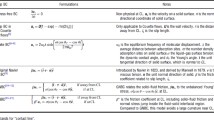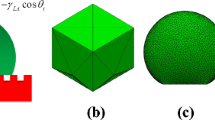Abstract
Wetting properties are significant for a hydrophobic surface and normally characterized by the equilibrium contact angle. In this manuscript, a mesoscopic method based on multiphase multiple-relaxation-time Lattice Boltzmann method has been presented and applied to simulate the contact angle at three-phase interfaces of a solid surface with micro-pillar structure. The influence of different parameters including pillar height, pillar width, inter-pillar spacing, intrinsic contact angle and the volume of the liquid drop on the equilibrium contact angle has been comprehensively investigated. The effect of geometry parameters of the micro-pillar structure on the wetting transition from Cassie–Baxter state to Wenzel state has also been studied. The results indicate that when the inter-pillar spacing is less than a certain value or the pillar height is greater than a certain value, the contact form between the droplet and the surface satisfies the Cassie–Baxter state. When the contact form satisfies the Cassie–Baxter state, the contact angle gradually increases with the increase of the inter-pillar spacing; the contact angle does not change significantly with the pillar height; the contact angle gradually decreases and approaches the intrinsic contact angle with the pillar width increases. Moreover, the contact angle increases with the increase of the intrinsic contact angle, and the contact angle is not sensitive to the change of droplet volume when the droplet volume is between 0.5 and10 μl.















Similar content being viewed by others
Data Availability
The datasets generated during and/or analyzed during the current study are available from the corresponding author on reasonable request.
References
Fukagata, K., Kasagi, N., & Koumoutsakos, P. (2006). A theoretical prediction of friction drag reduction in turbulent flow by superhydrophobic surfaces. Physics of Fluids, 18, 51701–51703.
Byun, D., Hong, J., Saputra, J. H. K., Lee, Y. J., Park, H. C., Byun, B., & Lukes, J. R. (2009). Wetting characteristics of insect wing surfaces. Journal of Bionic Engineering, 6, 63–70.
Dong, B. B., Wang, F. H., Abadikhah, H., Hao, L. Y., Xu, X., Khan, S. A., Wang, G., & Agathopoulos, S. (2019). Simple fabrication of concrete with remarkable self-cleaning ability, robust superhydrophobicity, tailored porosity, and highly thermal and sound insulation. ACS Applied Materials and Interfaces, 11, 42801–42807.
Wang, X., Xu, B., Chen, Z. Q., Yang, Y., & Cao, Q. (2021). Lattice Boltzmann simulation of dropwise condensation on the microstructured surfaces with different wettability and morphologies. International Journal of Thermal Sciences, 160, 106643.
Li, L., & Yuan, M. S. (2011). Modeling of drag reduction in turbulent channel flow with hydrophobic walls by FVM method and weakly-compressible flow equations. Acta Mechanica Sinica, 27, 200–207.
Zhang, B., Li, Q. B., Niu, X. J., Yang, L., Hu, Y., & Zhang, J. L. (2021). Influence of a novel hydrophobic agent on freeze-thaw resistance and microstructure of concrete. Construction and Building Materials, 269, 1–10.
Marmur, A., Volpe, C. D., Siboni, S., Amirfazli, A., & Drelich, J. W. (2017). Contact angles and wettability: Towards common and accurate terminology. Surface Innovations, 5, 3–8.
Pereira, P. M. M., Moita, A. S., Monteiro, G. A., & Prazeres, D. M. F. (2014). Characterization of the topography and wettability of English weed leaves and biomimetic replicas. Journal of Bionic Engineering, 11, 346–359.
Feng, L., Li, S. H., Li, Y. S., Li, H. J., Zhang, L. J., Zhai, J., Song, Y. L., Liu, B. Q., Jiang, L., & Zhu, D. B. (2002). Super-hydrophobic surfaces: From natural to artificial. Advanced Materials, 14, 1857–1860.
Lian, F., Tan, J. Z., & Zhang, H. C. (2014). The impact of the surface pattern on its wettability and antifouling performance. Journal of Functional Materials, 45, 2105–2109.
Yagub, A., Farhat, H., Kondaraju, S., & Singh, T. (2015). A lattice Boltzmann model for substrates with regularly structured surface roughness. Journal of Computational Physics, 301, 402–414.
Nakae, H., Yoshida, M., & Yokota, M. (2005). Effects of roughness pitch of surfaces on their wettability. Journal of Materials Science, 40, 2287–2293.
Öner, D., & McCarthy, T. J. (2000). Ultrahydrophobic surfaces. Effects of topography length scales on wettability. Langmuir, 16, 7777–7782.
Pan, G., Huang, Q. G., Hu, H. B., & Liu, Z. Y. (2010). Wettability of superhydrophobic surface through tuning microcosmic structure. Polymer Materials Science and Engineering, 26, 163–166.
Huang, Q. G., & Pan, G. (2015). Numerical simulation on wettability of hydrophobic surfaces based on lattice Boltzmann method. Journal of Functional Materials, 46, 10023–10028.
Venkateshan, D. G., & Tafreshi, H. V. (2018). Modelling droplet sliding angle on hydrophobic wire screens. Colloids and Surfaces A, 538, 310–319.
Khojasteh, D., Manshadi, M. K. D., Mousavi, S. M., Sotoudeh, F., Kamali, R., & Bordbar, A. (2020). Electrically modulated droplet impingement onto hydrophilic and (super) hydrophobic solid surfaces. Journal of the Brazilian Society of Mechanical Sciences and Engineering, 42, 153.
Jamali, M., Moghadam, A., Tafreshi, H. V., & Pourdeyhimi, B. (2018). Droplet adhesion to hydrophobic fibrous surfaces. Applied Surface Science, 456, 626–636.
Hosseini, S., Savaloni, H., & Shahraki, M. G. (2019). Influence of surface morphology and nano-structure on hydrophobicity: A molecular dynamics approach. Applied Surface Science, 485, 536–546.
Lia, H., & Zhang, K. (2019). Dynamic behavior of water droplets impacting on the superhydrophobic surface: Both experimental study and molecular dynamics simulation study. Applied Surface Science, 498, 143793.
Ambrosia, M. S., Ha, M. Y., & Balachandar, S. (2013). The effect of pillar surface fraction and pillar height on contact angles using molecular dynamics. Applied Surface Science, 282, 211–216.
Ahmad, S., Zhao, J. Y., Shahzad, A., Qadri, M. N. M., & Tang, H. (2021). Droplet impact on nano-textured bumps: Topology effects. Computers and Fluids, 218, 104844.
Wang, X., Lin, D. J., Wang, Y. B., Gao, S. R., Yang, Y. R., & Wang, X. D. (2020). Rebound dynamics of two droplets simultaneously impacting a flat superhydrophobic surface. American Institute of Chemical Engineers, 66, e16647.
Pravinraj, T., & Patrikar, R. (2017). Modelling and investigation of partial wetting surfaces for drop dynamics using lattice Boltzmann method. Applied Surface Science, 409, 214–222.
Jansen, H. P., Sotthewes, K., Zandvliet, H. J. W., & Kooij, E. S. (2016). Potential of lattice Boltzmann to model droplets on chemically stripe-patterned substrates. Applied Surface Science, 361, 122–132.
Premnath, K. N., & Banerjee, S. (2011). On the three-dimensional central moment lattice Boltzmann method. Journal of Statistical Physics, 143, 747–794.
D’Humières, D., Krafczyk, M., Lallemand, P., & Luo, L. S. (2002). Multiple-relaxation-time lattice Boltzmann models in three dimensions. Philosophical Transactions: Mathematical, Physical and Engineering Sciences, 360, 437–451.
Lallemand, P., & Luo, L. (2000). Theory of the lattice Boltzmann method: Dispersion, dissipation, isotropy, Galilean invariance, and stability. Physical Review E, 61, 6546–6562.
Wenzel, R. N. (1936). Resistance of solid surfaces to wetting by water. Industrial and Engineering Chemistry, 28, 988–994.
Wenzel, R. N. (1949). Surface roughness and contact angle. The Journal of Physical and Colloid Chemistry, 53, 1466–1467.
Cassie, A. B. D., & Baxter, S. (1944). Wettability of porous surfaces. Transactions of the Faraday Society, 40, 546–551.
Young, T. (1805). An essay on the cohesion of fluids. Philosophical Transactions of the Royal Society of London, 95, 65–87.
Wang, H. B., Kong, Y. X., Cheng, S., & You, H. F. (2020). Effect of micro/nano-scale structures on wettability of surface based on LBM. Journal of Materials Science and Engineering, 38, 245–249.
Li, Q., Luo, K. H., & Li, X. J. (2013). Lattice Boltzmann modeling of multiphase flows at large density ratio with an improved pseudopotential model. Physical Review E, 87, 53301.
Guo, Z. L., & Zheng, C. G. (2008). Analysis of lattice Boltzmann equation for microscale gas flows: Relaxation times, boundary conditions and the Knudsen layer. International Journal of Computational Fluid Dynamics, 22, 465–473.
Li, Q., He, Y. L., Tang, G. H., & Tao, W. Q. (2010). Improved axisymmetric lattice Boltzmann scheme. Physical Review E, 81, 56707.
Shan, X. W. (2008). Pressure tensor calculation in a class of nonideal gas lattice Boltzmann models. Physical Review E, 77, 066702.
Yu, Z., & Fan, L. S. (2010). Multirelaxation-time interaction-potential-based lattice Boltzmann model for two-phase flow. Physical Review E, 82, 46708.
Guo, Z. L., Zheng, C. G., & Shi, B. C. (2002). Discrete lattice effects on the forcing term in the lattice Boltzmann method. Physical Review E, 65, 46308.
Yan, Y. Y. (2009). Physical and numerical modelling of biomimetic approaches of natural hydrophobic surfaces. Chinese Science Bulletin, 54, 541–548.
Stalder, A. F., Kulik, G., Sage, D., Barbieri, L., & Hoffmann, P. (2006). A snake-based approach to accurate determination of both contact points and contact angles. Colloids and Surfaces A: Physicochemical and Engineering Aspects, 286, 92–103.
Hasan, M., Warzywoda, J., & Kumar, G. (2018). Decoupling the effects of surface texture and chemistry on the wetting of metallic glasses. Applied Surface Science, 447, 355–362.
Zhao, T. Y., & Jiang, L. (2018). Contact angle measurement of natural materials. Colloids and Surfaces B: Biointerfaces, 161, 324–330.
He, Y., Jiang, C. Y., Wang, S. K., Yin, H. X., & Yuan, W. Z. (2013). Control wetting state transition by microrod geometry. Applied Surface Science, 285, 682–687.
Acknowledgements
The authors are grateful for the financial support from the National Natural Science Foundation of China (Grant no. 12172377 and Grant no. 11772351) and the Open Research Fund of Key Laboratory of Construction and Safety of Water Engineering of the Ministry of Water Resources, China Institute of Water Resources and Hydropower Research (Grant no. 202007).
Author information
Authors and Affiliations
Corresponding author
Ethics declarations
Conflict of interest
The authors have no competing interests to declare that are relevant to the content of this article.
Additional information
Publisher's Note
Springer Nature remains neutral with regard to jurisdictional claims in published maps and institutional affiliations.
Rights and permissions
About this article
Cite this article
Tian, L., Qiu, L. Modeling the Wettability of Microstructured Hydrophobic Surface Using Multiple-relaxation-time Lattice Boltzmann Method. J Bionic Eng 19, 1460–1471 (2022). https://doi.org/10.1007/s42235-022-00204-1
Received:
Revised:
Accepted:
Published:
Issue Date:
DOI: https://doi.org/10.1007/s42235-022-00204-1




